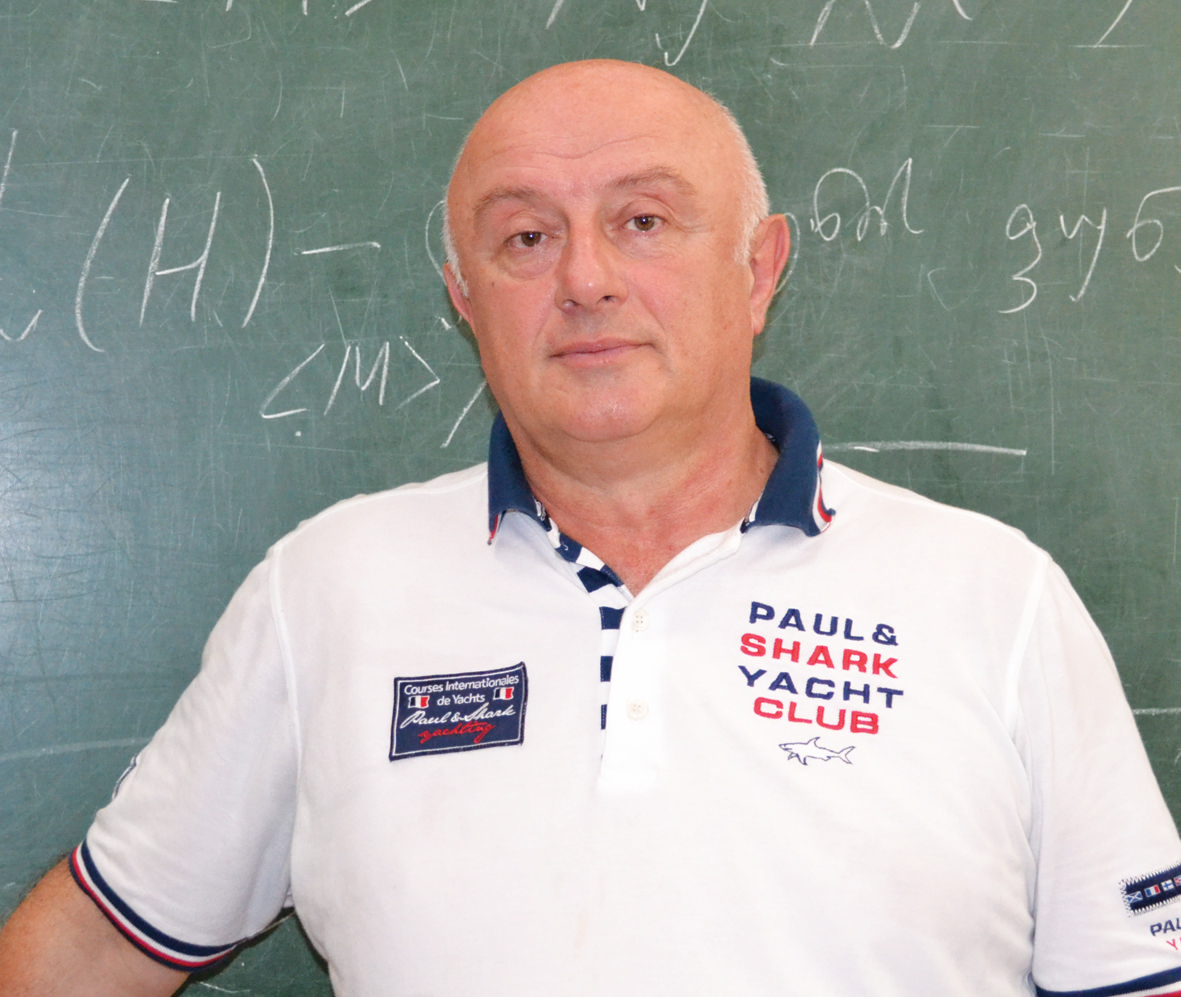
FACULTY OF EXACT AND NATURAL SCIENCES
Magnetic Nanoparticles for Biomedical Applications
Over the past years nanotechnology has been established as one of the most dynamically developing interdisciplinary sciences. Potential applications for nanomaterials in medicine and pharmacology are many and this has become a priority direction that will lead to solutions for some of the most painful health problems. However, modern nanotechnologies necessitate the creation of new directions of scientific research—uniting the scientific achievements of nanotechnology and biotechnology has led to the creation of a new discipline – nanobiotechnology. This will lead to nanoconstructions that can manage biosystems at a molecular level. Nanofluids consisting of magnetic nanoparticles are of special interest.
The term “nanotechnology” means the creation and use of equipment and systems on the basis of nanometric-size substances. Nanotechnology enables the manipulation of matter on an atomic and molecular scale, not only permitting scientists to create devices invisible to the naked eye, but increasing the accuracy and reliability of their actions. This new technology is also contributing to the creation of materials with unusual properties.
 Magnetic nanoparticles are characterized by many unique magnetic properties, including superparamagnetism (a form of magnetism that appears in small ferromagnetic or ferrimagnetic nanoparticles), low Curie temperature, high magnetic susceptibility, etc. Nanoparticles provide the potential for researchers in a growing number of fields: magnetic fluids, data placement, catalyses and bio applications. Today nanoparticles are widely used in biology--in magnetic bioseparation and identification of biological objects (cell, albumen, nucleic acid, ferments, bacteria, viruses, etc.); clinical diagnosis and therapy (including magnetic resonance imaging, hyperthermia caused by magnetic nanofluids); purposeful medication; and biological indications. A magnetic nanofluid is a suspension of Fe3O4 ultra-dispersive nanoparticles, which scientists can obtain through alkaline sedimentation of crystal hydrate mixtures of two and three valence iron salts.
Magnetic nanoparticles are characterized by many unique magnetic properties, including superparamagnetism (a form of magnetism that appears in small ferromagnetic or ferrimagnetic nanoparticles), low Curie temperature, high magnetic susceptibility, etc. Nanoparticles provide the potential for researchers in a growing number of fields: magnetic fluids, data placement, catalyses and bio applications. Today nanoparticles are widely used in biology--in magnetic bioseparation and identification of biological objects (cell, albumen, nucleic acid, ferments, bacteria, viruses, etc.); clinical diagnosis and therapy (including magnetic resonance imaging, hyperthermia caused by magnetic nanofluids); purposeful medication; and biological indications. A magnetic nanofluid is a suspension of Fe3O4 ultra-dispersive nanoparticles, which scientists can obtain through alkaline sedimentation of crystal hydrate mixtures of two and three valence iron salts.
Several years ago an experimental device based on the electro-hydraulic effect was created at the Institute of Cybernetics at the Georgian Technical University. Using this device, solid particles of magnetite are additionally loosened in liquid causing many high-dispersive magnetic particles to be received. The low capacity of the equipment (maximum voltage 10kW; capacity 2.5 MGW at discharge) and the small amount of processing solution and weak control of the entire process have meant that the device requires further improvement. The employees of the Andronikashvili Institute of Physics and the Institute of Cybernetics at the TSU Faculty of Exact and Natural Sciences are now involved in modernizing this electro-hydraulic device.
Shalva Kekutia is Chief Fellow at the Vladimer Chavchavadze Institute of Cybernetics of the Georgian Technical University, and Academic Director of Physical and Mathematical Sciences. He explained one application of their research. In cases of intravenous injections--because of the great numeric values of the surface area to the volume ratio in nanoparticles--there is a tendency for aggregation and plasma albumin adsorption to take place. As a result, the reticuloendothelial system quickly recognizes these nanoparticles. Thus, to increase bioconformity and stabilization, nanoparticles have been given a special coating. Besides protecting against aggregation, oxidation, or acidic and alkaline corrosion, this coating can play a role as “spacer” for the connection of pharmaceutical agents or bio-molecules with magnetic carriers. Thus, medical nanoparticles face several consecutive tasks: find target cells in a living organism, deliver drugs, penetrate into the cells, absorb their content, and then separate into pieces and leave the organism.”
 The scientist notes that the permission issued by the Georgian Pharmacological Committee on using magnetic nanofluids in clinical cases fostered cooperation between the medical center Marriage and Family Plus and the Medical Cybernetics Laboratory of the Institute of Cybernetics, led by Professor Mikheil Akhalaia, MD, a well-known surgeon and laureate of the State Award. The Marriage and Family Plus Medical Center uses magnetic nanofluids synthesized by the group, which is currently led by one of the authors of the given article. Magnetic nanoparticles coated with ascorbic acid are used to treat patients diagnosed with cervititis, colpites and bartholinitis, leading to a recovery rate in 98% of patients, and healing is often faster than with other means.
The scientist notes that the permission issued by the Georgian Pharmacological Committee on using magnetic nanofluids in clinical cases fostered cooperation between the medical center Marriage and Family Plus and the Medical Cybernetics Laboratory of the Institute of Cybernetics, led by Professor Mikheil Akhalaia, MD, a well-known surgeon and laureate of the State Award. The Marriage and Family Plus Medical Center uses magnetic nanofluids synthesized by the group, which is currently led by one of the authors of the given article. Magnetic nanoparticles coated with ascorbic acid are used to treat patients diagnosed with cervititis, colpites and bartholinitis, leading to a recovery rate in 98% of patients, and healing is often faster than with other means.
In medicine, increased efforts are being made to create substances that suppress the growth and development of toxic microorganisms (bacteriostatic) or that kill them (bactericide). These substances hamper the creation of drug-resistant bacteria. It is well-known that the main cause for wound complications is the proliferation of microbes in the wound. Therefore it is extremely important to create functional magnetic nanofluids with strong bactericide properties. Research conducted by our laboratory has shown that magnetic nanofluids are not characterized by selective bacteriocidity towards any microorganisms, thus processed mass can be removed from the wound without any contact, with the help of a magnetic field. Because of their magnetic properties, our synthesized nanomaterials can easily penetrate even into deep wounds.
In order to improve the effect, magnetic treatment took place a year ago through the method created jointly by the Institute of Cybernetics and TSU Science. TSU Professor Archil Ugulava from the Faculty of Exact and Natural Sciences explained that one of the key properties of magnetic nanofluids is the dependence of its magnetic moment on the magnetic field. Analysis of magnetic nanofluid samples was carried out by D. Daraselia and D. Japaridze through a vibrating sample magnetometer (VSM) at the Super High Frequency Laboratory of the TSU Department of Condensed Matter Physics. One of the results of the analysis is shown in Pic.2.
We can conclude that the system of nanoparticles magnetizes when a magnetic field is applied. By increasing the magnetic field, the magnetic moment of nanoparticles also increases, while a very strong fields lead to a saturation effect, after which the increased magnetic field does not cause the increase of the magnetic moment. The research also showed that the system of our nanoparticles does not create a hysteresis loop; it does not have a remaining magnetic moment (meaning that in case the external magnetic field is turned off the net moment of the particle becomes zero). What is most important is that these nanoparticles belong to the category of superparamagnetic materials. This fact is essential and decisive for the biomedical application of nanoparticles.
Using magnetic nanoparticles in case of intra-articular injections is convenient. For example, the etiology of osteoarthritis is still unknown and today treatment consists only of the reduction of pain and inflammation instead of rehabilitation. Therefore, new approaches are needed that will promote rehabilitation processes in the human organism. In other words a key goal of this method is to promote self-restoration of cartilage and bone, facilitated by magnetic nanoparticles.
To prolong the action of anti-inflammatory drugs, a magnetic container of functional magnetic nanoparticles adjusted to joints has been developed (the Institute of Cybernetics). Due to a gradual release of active substances and their localization, treatment will be very effective. To this end, Fe3O4 super-magnetic nanoparticles are synthesized with medications. Unlike existing methods, the new technique of “localized” recovery provides a unique opportunity for carrying out intra-articular treatment that bypasses external influences.
According to Professors Archil Ugulava and Shalva Kekutia, joint work in these directions will continue at the TSU Faculty of Exact and Natural Sciences and the Institute of Cybernetics. Future research will be oriented towards the creation of high-tech products with potentially high demand on international markets. In addition to technological and experimental studies, theoretical research on synthesized materials will be conducted, resulting in the creation of a permanent technological line for the synthesis of medical nanomaterials, electro-hydraulic equipment, magnetic nanofluids or an industrial prototype of superparamagnetic functional Fe3O4 powders. With improved technology, this permanent technological line will ensure the high quality of nanoproducts and the reproduction of magnetic nanoparticles.




